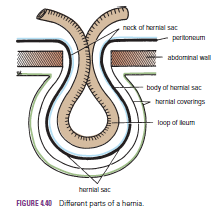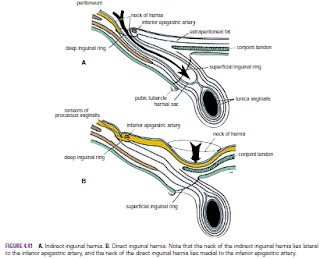Abdominal
Herniae
A hernia is the protrusion of part of the abdominal contents
beyond the normal confines of the abdominal wall. It consists of three parts:
the sac, the contents of the sac, and the coverings of the sac. The hernial sac
is a pouch (diverticulum) of peritoneum and has a neck and a body. The hernial
contents may consist of any structure found within the abdominal cavity and may
vary from a small piece of omentum to a large viscus such as the kidney. The
hernial coverings are formed from the layers of the abdominal wall through
which the hernial sac passes. Abdominal herniae are of the following common
types:
Inguinal
(indirect or direct)
Femoral
Umbilical (congenital or acquired)
Epigastric
Separation of the recti abdominis
Incisional
Hernia of the linea semilunaris (Spigelian hernia)
Lumbar
Femoral
Umbilical (congenital or acquired)
Epigastric
Separation of the recti abdominis
Incisional
Hernia of the linea semilunaris (Spigelian hernia)
Lumbar
Indirect
Inguinal Hernia
The indirect inguinal hernia is the most common form of
hernia It is more common than a direct inguinal hernia. It is much more common
in males than females. and is believed
to be congenital in origin . The hernial sac is the remains of the processus
vaginalis (an outpouching of peritoneum that in the fetus is responsible for
the formation of the inguinal canal . It follows that the sac enters the inguinal
canal through the deep inguinal ring lateral to the inferior epigastric
vessels. It may extend part of the way along the canal or the full length, as
far as the superficial inguinal ring. If the processus vaginalis has undergone
no obliteration, then the hernia is complete and extends through the
superficial inguinal ring down into the scrotum or labium majus. Under these
circumstances, the neck of the hernial sac lies at the deep inguinal ring
lateral to the inferior epigastric vessels, and the body of the sac resides in
the inguinal canal and scrotum (or base of labium majus). An indirect inguinal
hernia is about 20 times more common in males than in females, and nearly one
third are bilateral. It is more common on the right (normally, the right processus
vaginalis becomes obliterated after the left; the right testis descends later
than the left). It is most common in children and young adults
Direct
Inguinal Hernia
The direct inguinal hernia It is common in old men with weak
abdominal muscles and it makes up about 15% of all inguinal hernias it is rare
in women . The sac of a direct hernia bulges directly anteriorly through the
posterior wall of the inguinal canal medial to the inferior epigastric
vessels and The neck of the hernial sac
is wide. Because of the presence of the strong conjoint tendon (combined
tendons of insertion of the internal oblique and transversus muscles), this
hernia is usually nothing more than a generalized bulge; therefore, the neck of
the hernial sac is wide. Direct inguinal hernias are rare in women and most are
bilateral. It is a disease of old men with weak abdominal muscles.


No comments:
Post a Comment